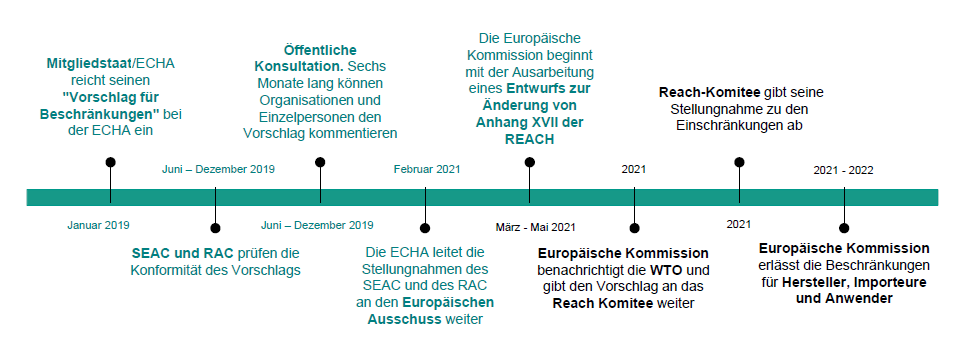Regulations
EU Directives and Regulations
The EU is the first to address all microplastics intentionally added in products, and not just microbeads used in cosmetics. This is part of our comprehensive approach to tackle microplastics, which are potentially harmfulfor marine life, and enter our food chain, with yet unknown impacts on human health.
Elżbieta Bieńkowska (former Commissioner for the Internal Market):
ECHA (2019): Proposal for a restriction
Europäische Kommission - Pressemitteilung vom 30.01.2019
Final Report European Commission (DG Environment)
ICF (2018): Final Report for DG Environment
Directive (EU) 2019/904
EU (2019 / 1009): EU regulation on fertilizer products
Bio-Based Products: DIN EN 16785-2
Microbead-Free Waters Act
New York State Microbeads Ban
State Microplastics Ban
Microbead Ban (Kannada)
Canadian Plastics Industry Association
Kanadische Umweltstandards
Based on Article 69(1) of the REACH Regulation, ECHA has prepared a detailed proposal in which health and economic risks are weighed.
The goal is to achieve the reduction of up to 400,000 tons of microplastics within the next 20 years. To this end, ECHA has proposed concrete sector-specific restrictions.
This proposal is now being voted on by the EU. A decision is expected before the end of 2021.
The European Commission welcomes ECHA's opinion on the restriction of microplastics intentionally added to products.
As part of the EU Plastics Strategy, the European Chemicals Agency (ECHA), at the request of the European Commission, has assessed the health and environmental risks posed by intentionally added microplastics and concluded that an EU-wide restriction would be justified.
"Absichtlich hinzugefügtes Mikroplastik in Produkten"
Final report on the devastating effects of microplastics on flora, fauna, environment, economy and health.
The aim of this study is to investigate the use of microplastics in products, with a particular focus on
Microbeads, which are made of man-made conventional plastics.
The objective of this study is to critically evaluate all available information on sources, pathways and impacts of microplastics in the aquatic environment and on measures to reduce them.
This study only addresses microplastics generated during the life cycle of a product due to wear and tear or emitted by accidental spills.
Directive of the European Parliament, which aims to reduce the negative impact of certain plastic products on the environment. It includes a timetable that regulates the implementation of these plastic bans on a sector-specific basis. The aim is to reduce the release of plastic and microplastics.
From 2024, polymers used in fertilizers must be at least 90% degraded after 48 months. Conventional polymers are made of plastic and will therefore be banned.
BIOMERE meet these requirements.
"The purpose of this European Standard is to provide a method for determining the biobased content of solid, liquid, gaseous products based on the calculation of materials entering and leaving the system and on the traceability of the material during processing to confirm the physical presence of the biobased material in the output. Although not the purpose of this procedure, the required biobased content of the output can be validated by analysis using EN 16785 1. The DIN working committee responsible for this standard is NA 172-00-11 AA "Biobased products" in the DIN standards committee Fundamentals of Environmental Protection (NAGUS)." Source
Dieses Gesetz wurde 2015 verabschiedet und verbietet den Einsatz von Mikroplastikpartikeln in Kosmetika, wie z.B. in Zahnpasta, Körperpeelings und Reinigungsmitteln. Das Gesetz verbietet auch den Verkauf von Produkten, die Mikroplastikpartikel enthalten.
Federal Action Plan on Marine Litter: Im Jahr 2018 hat die US-amerikanische Regierung einen Aktionsplan zur Reduzierung von Meeresmüll veröffentlicht, der auch die Bekämpfung von Mikroplastik umfasst. Der Aktionsplan enthält Maßnahmen zur Reduzierung des Einsatzes von Mikroplastik in Produkten, zur Förderung der Forschung zu den Auswirkungen von Mikroplastik auf die Umwelt und zur Verbesserung der Müllentsorgung.
Im Jahr 2015 hat der Bundesstaat New York ein Verbot von Mikroplastikpartikeln in Kosmetika erlassen, ähnlich wie der Microbead-Free Waters Act auf Bundesebene.
Kaliforniens Proposition 65: Diese Proposition erfordert, dass Unternehmen öffentlich deklarieren müssen, wenn ihre Produkte Chemikalien enthalten, die Krebs oder Fortpflanzungsschäden verursachen können. Mikroplastik wird als eine solche Chemikalie betrachtet und muss daher in Produkten, die in Kalifornien verkauft werden, deklariert werden.
Mehrere Bundesstaaten, darunter Illinois, Maine, Colorado und Connecticut, haben Gesetze erlassen, die den Einsatz von Mikroplastik in bestimmten Produkten einschränken oder verbieten.
Es ist zu beachten, dass die Bemühungen zur Reduzierung des Einsatzes von Mikroplastik in den USA noch nicht auf Bundesebene umfassend und einheitlich sind. Einige Initiativen sind auf Bundesstaatsebene begrenzt, während andere Initiativen auf die Einschränkung bestimmter Anwendungen von Mikroplastik beschränkt sind.
Dieses Gesetz wurde 2018 verabschiedet und verbietet den Einsatz von Mikroplastikpartikeln in Körperpflegeprodukten wie Zahnpasta, Duschgel und Reinigungsmitteln. Das Verbot gilt auch für den Import von Produkten, die Mikroplastikpartikel enthalten.
Plastic Microbead Ban Regulations: Im Jahr 2017 wurden die Plastic Microbead Ban Regulations verabschiedet, die den Einsatz von Mikroplastikpartikeln in kosmetischen Produkten verbieten. Das Verbot umfasst sowohl den Verkauf als auch die Herstellung von Produkten, die Mikroplastikpartikel enthalten.
Canadian Plastics Industry Association: Die Canadian Plastics Industry Association hat sich verpflichtet, den Einsatz von Mikroplastikpartikeln in ihren Produkten bis zum Jahr 2021 zu beenden.
Die Canadian Plastics Industry Association hat sich verpflichtet, den Einsatz von Mikroplastikpartikeln in ihren Produkten bis zum Jahr 2021 zu beenden.
Gewässerschutzgesetz: Im Jahr 2012 wurde das Gewässerschutzgesetz (Watershed Protection Act) verabschiedet, das Unternehmen dazu verpflichtet, die Umweltauswirkungen ihrer Produkte zu berücksichtigen und Maßnahmen zur Reduzierung von Umweltverschmutzung und Umweltverschlechterung zu ergreifen.
Es gibt verschiedene Umweltstandards in Kanada, die auf die Reduzierung von Mikroplastik abzielen, darunter der Environmental Choice Program und der EcoLogo Program. Diese Standards legen Kriterien für die Produkte und Dienstleistungen fest, die als umweltfreundlich gelten.
Chemicals Bans in the EU

